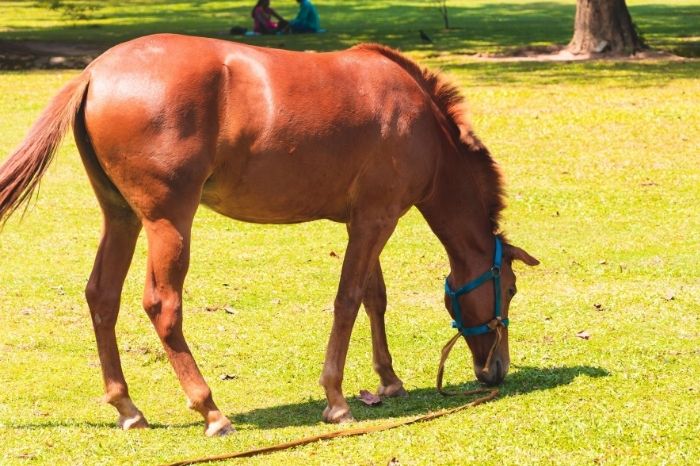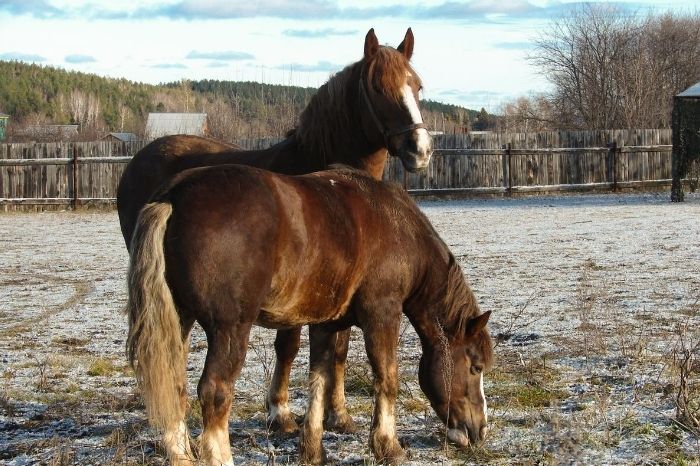Last Updated on April 7, 2023
Just about every horse owner, especially those with older horses, has wondered, how quickly can a horse founder on grass. A founder can be a serious illness, but it is preventable and treatable. Founder, also known as laminitis, can occur in horses of any age, though it is more likely to happen in older horses.
One of the most common ways for horses to founder is by overeating grass. Though grass is an important part of a horse’s diet, too much can cause serious issues. Horses eating fresh spring grass after a long winter are more prone to founder.
What is Founder in Horses?
Founder is caused by inflammation of the blood-rich laminae that connect the hoof wall to the bones that lie within the hoof capsule of the horse. These laminae act like incredibly strong velcro, but when they become inflamed the bond between them weakens. This is very painful for the horse, and can also result in some incredibly detrimental structural changes within the hoof capsule itself.
In a horse with founder, also known as laminitis, the body weight of the horse exerts pressure on the weakened laminae, causing them to pull apart. This creates tiny gaps between the hoof wall and pedal bone, allowing the pedal bone to move away from the hoof wall. The bone will either rotate, sink (founder), or both. When this occurs, the horse will require many months or even years of remedial farriery work to return the hoof to normal.
A diagnosis of founder or laminitis in horses is a serious issue, and horse owners should do as much as possible to try and prevent this issue from occurring. To do this, it helps to have a good understanding of why horses founder and how to prevent it from happening.
Why Do Horses Founder on Grass?
In recent years the understanding of why horses founder has greatly increased. Previously it was thought that founder happened when a healthy horse ate too much grass over a short period, but it has become clear that many of these horses may have been already suffering from undiagnosed health problems.
It has been discovered that most horses that founder have one of two health problems – Equine Metabolic Syndrome (EMS) or Cushing’s Disease (PPID). Both of these diseases cause poor regulation of blood sugar levels, and these horses often become resistant to the levels of insulin within the bloodstream. In EMS, the primary cause is normally abnormal levels of body fat, so this condition is very common in horses that are overweight or obese. In PPID, the pituitary gland loses the ability to regulate metabolic functions adequately.
When a horse with either of these conditions consumes food with high levels of carbohydrates in the form of fructans, also known as sugars, an episode of founder is highly likely to occur. And because at certain times of the yea,r grass can be very high in fructans, it can be the triggering factor in an episode of laminitis. For this reason, the term ‘grass founder’ has been used for many years, even though these horses were likely to be already suffering from altered metabolism beforehand.
How quickly can a horse founder on grass?
The rate at which a horse can founder on grass will depend on the levels of fructans in the grass and how susceptible the horse is to them. In the spring, grass tends to be very high in fructans, particularly in certain high-risk situations:
- Rapidly-growing lush grass contains higher levels of fructans
- Grass that has been grazed short during the winter will grow rapidly and produce high levels of fructans
- In the spring, warm days and cool nights trigger increased fructan levels
In a horse or pony that is already predisposed to founder or laminitis, such as one that is obese, just a few hours grazing on pasture that is high in fructans may be enough to trigger an episode of grass founder.
Grass founder symptoms & treatment
In a horse with founder, the first symptom seen is often mild lameness or a reluctance to walk on hard or stony ground. The horse is commonly lame in both front feet, so a shortened, stilted gait is commonly seen. The horse will shift their weight from side to side while standing in an attempt to ease the pain, or may stand with their forelimbs extended forwards. An increased digital pulse indicates increased blood flow to the hoof capsule as a result of inflammation.
The first step in grass founder treatment is to immediately remove the horse from any foodstuffs that are high in fructan and to confine them to a stall with a soft, comfortable bed to encourage them to lie down. It is vital to get any suspected case of founder examined by a veterinarian straight away, as any delay in treatment can severely prolong your horse’s recovery time.
How to prevent grass founder in horses
For horses that are already prone to founder, their time on grass should be limited, especially at the beginning of spring. This includes horses that are overweight, obese or those that have been diagnosed with PPID or EMS. The single best thing you can do to prevent founder is to keep your horse at a healthy bodyweight, reducing the risk of EMS and insulin resistance. Whilst PPID (Cushing’s Disease) is not curable, it can be treated with long-term medication which will reduce the risk of laminitis.
During high-risk periods, horses at risk of foundering can be turned out on a dry lot for exercise. Grazing muzzles can also help prevent a horse from eating too much fresh grass. Never turn a laminitis-prone horse out onto spring grass when the nighttime temperatures drop below 40 degrees Fahrenheit. Allowing your horse to fill up on hay may also help to slow their grass intake and reduce spikes in blood sugar levels.
When can my foundered horse eat grass again?
When a horse has foundered once, it is at a higher risk of happening again in the future. This means that extreme care must be taken to reduce any risk factors that may lead to an episode of founder.
Most veterinarians advise that any underlying hormonal problems must be treated before the horse is allowed to eat grass again. So, if your horse has been diagnosed with Cushing’s disease, it may take several weeks for the medication to take effect and return hormonal levels to normal.
With founder that was triggered by EMS, the wait may be even longer before your horse can eat grass again. Your horse will need a long weight-loss program and regular exercise to return its body weight to normal. Only once the excess weight is lost and the hormonal levels are under control will your horse be permitted to eat grass again.
Once your horse can eat grass, it can be a good idea to graze them on pasture that contains a high proportion of clover or alfalfa. Legumes are lower in fructans than grass and will reduce the risk of laminitis.
Can a Horse Founder on Hay?
Horses can potentially founder on hay, but only if they are suffering from a pre-existing medical condition or are severely overweight. The key to reducing the risk of founder in horses is feeding a diet that is low in fructans, and maintaining a good body condition score. Feeding an obese horse large amounts of nutrient-dense hay could cause the horse to founder.
If your horse is prone to founder, feed hay that is low in soluble carbohydrates – ideally, hay that is cut from mature pasture in the summer months. To reduce the nutrient levels further, the hay can be soaked for up to 60 minutes.
Summary – How Quickly Can a Horse Founder on Grass?
So, as we have learned, horses that suffer from pre-existing health problems can founder in just a few hours if allowed unlimited access to grass that is high in fructans. Horses of any age that are overweight or obese can founder on grass, as can older horses suffering from untreated Cushing’s disease. The highest risk period is during the spring months, particularly on pasture that was grazed short during the winter months.
We would love to hear your thoughts about how quickly can a horse founder on grass! Leave a comment below, and share this article with your horse-mad friends!


